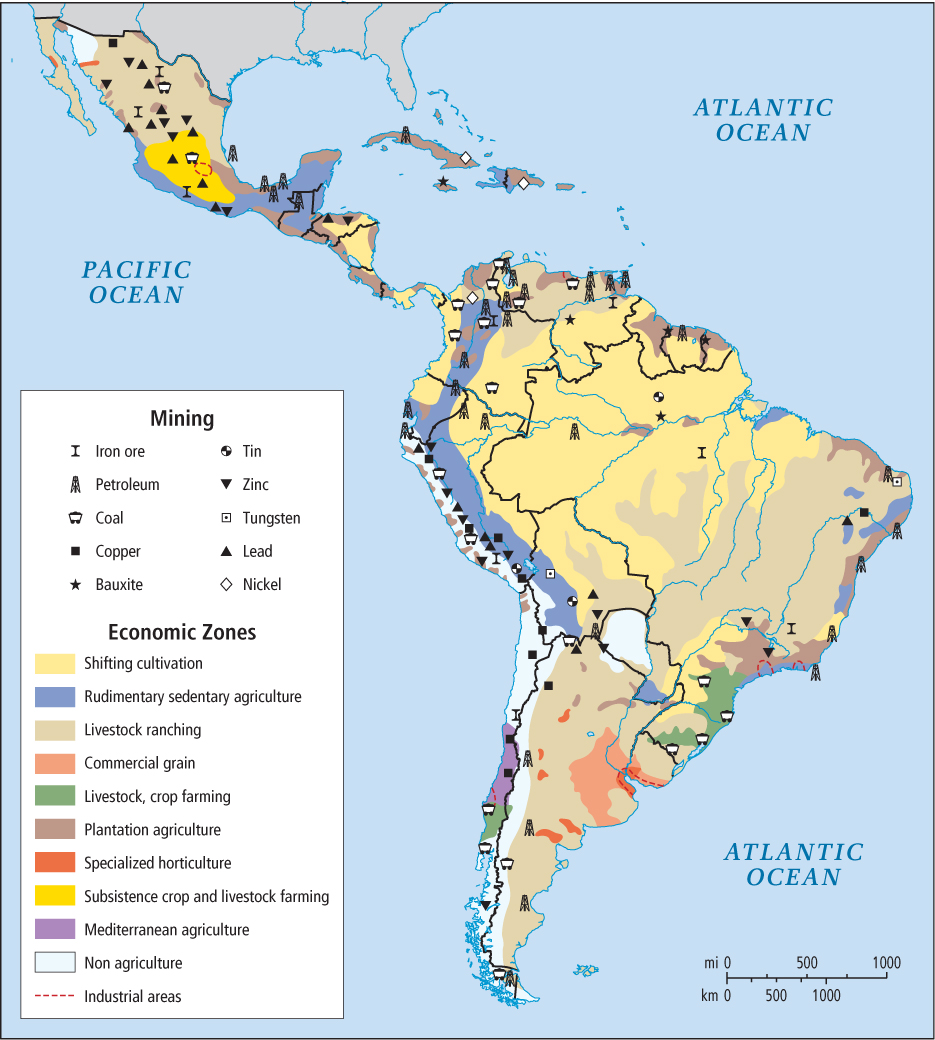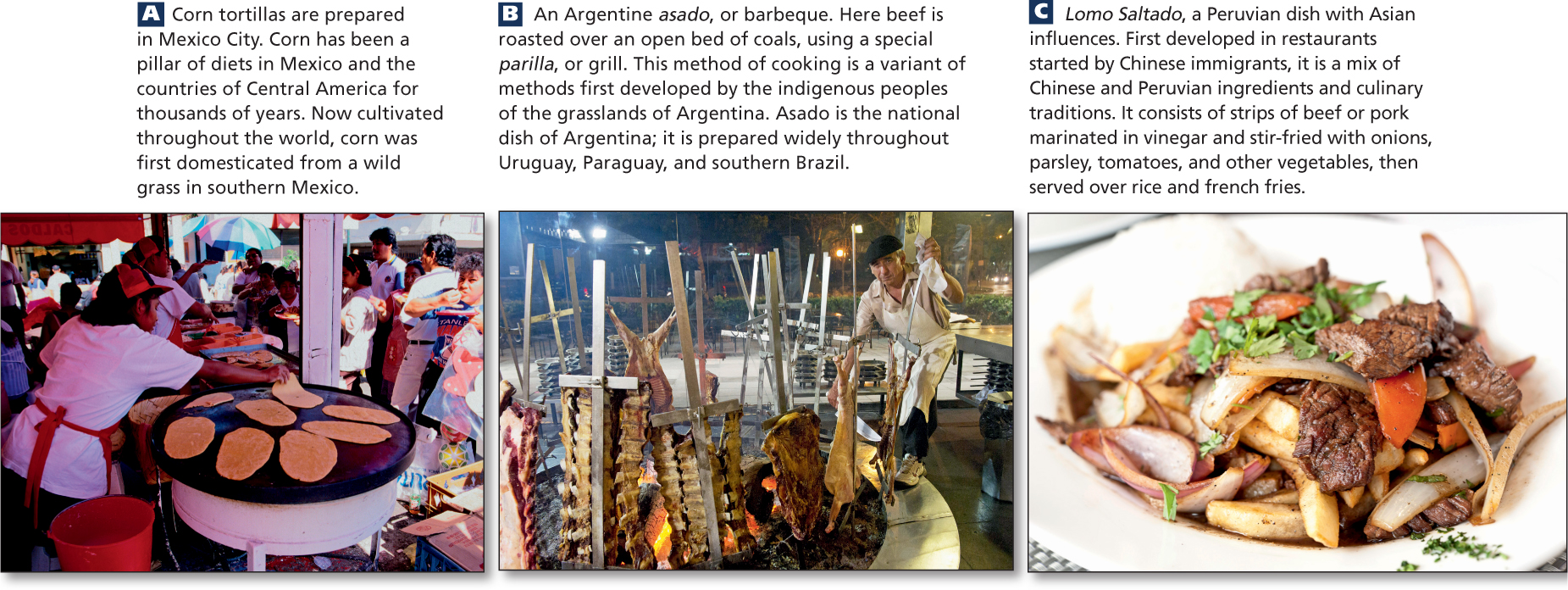Food Production and Contested Space
Geographic Insight 4
Food and Urbanization: The shift from small-scale subsistence food production to mechanized agriculture for export has fueled migration to cities. Many places previously were self-sufficient with regard to food; they now depend on imported food, making them susceptible to food insecurity.
The agricultural lands of Middle and South America (Figure 3.16) are examples of what geographers call contested space, where various groups are in conflict over the right to use a specific territory as each sees fit. The conflicts take place at various scales, as the following four case studies demonstrate, and all are in one way or another related to inequities that have been in place at least since colonial times. They also relate to a region-wide shift toward mechanized agriculture for export (see Chapter 1, page 24).

contested space any area that several groups claim or want to use in different and often conflicting ways, such as the Amazon or Palestine
Local Scale: A Banana Worker in Costa Rica
For centuries, while people labored for very low wages on haciendas, the hacienda owners would at least allow them a bit of land to grow a small garden or some cash crops. In recent years, however, SAPs encouraged a shift to large-scale, mechanized, export-oriented agriculture, also known as green revolution agriculture. The rationale was that these operations could earn larger profits that could help countries pay off debts faster. SAPs made it easier for foreign multinational corporations, such as Del Monte, to use their large financial resources to buy up many haciendas and other farms, converting them to plantations. However, this also forced many rural people off lands they once cultivated, and onto plantations, where they now work as migrant laborers for low wages, as the following story illustrates.
150
ON THE BRIGHT SIDE
Children and the Landless Movement
In Brazil, the children of those in the MST movement find living in the landless protestor encampments a source of pride and positive identity. They learn both subsistence and leadership skills, gain knowledge of the natural environment, practice communitarian values, and are proud of the stance their parents have taken, as the video by Michalis Kontopodis, “Landless Children/Sem Terrinha” (http://tinyurl.com/9pxeclw), attests.
VIGNETTE
Aguilar Busto Rosalino used to work on a Costa Rican hacienda. He had a plot on which to grow his own food and in return worked 3 days a week for the hacienda. Since a banana plantation took over the hacienda, he rises well before dawn and works 5 days a week from 5:00 a.m. to 6:00 p.m., stopping only for a half-hour lunch break. Because he now lacks the time and land to farm, he must buy most of his food.
Aguilar places plastic bags containing pesticide around bunches of young bananas. He prefers this work to his last assignment of spraying a more powerful pesticide, which left him and 10,000 other plantation workers sterile. He works very hard because he is paid according to how many bananas he treats. Usually he earns between $5.00 and $14.50 a day.
It is common practice for these banana operations to fire their workers every 3 months so that they can avoid paying the employee benefits that Costa Rican law mandates. Although Aguilar makes barely enough to live on, he has no plans to press for higher wages because he knows that he would be put on a “blacklist” of people that the plantations agree not to hire. [Source: Andrew Wheat. For detailed source information, see Text Credit pages.]
Provincial Scale: The Zapatista Rebellion
In the southern Mexican state of Chiapas, agricultural activists and indigenous leaders have mobilized armed opposition to the economic and political systems that have left them poor and powerless. The Mexican government redistributed some hacienda lands to poor farmers early in the twentieth century, but most fertile land in Chiapas is still held by a wealthy few who use green revolution agriculture to grow cash crops for export. The poor majority farm tiny plots on infertile hillsides. In 2000, about three-fourths of the rural population was malnourished, and one-third of the children did not attend school.
The Zapatista rebellion (named for the hero of the 1910 Mexican revolution, Emiliano Zapata) began on the day the North American Free Trade Agreement took effect in 1994. The Zapatistas view NAFTA as a threat because it diverts the support of the Mexican federal government from land reform to large-scale, export-oriented green revolution agriculture. The Mexican government used the army to suppress the rebellion.
In 2003, after 9 years of armed resistance, the Zapatista movement redirected part of its energies. It began a nonviolent political campaign to democratize local communities by setting up people’s governing bodies parallel to local official governments. Before the national elections in 2006, the Zapatistas toured the country in an effort to turn the political climate against globalization and toward greater support for indigenous people and the poor. The election ended in a near tie, but in the end, the Zapatista-favored candidate lost. The Zapatistas continue to be active in efforts to reform Mexican politics to include more grassroots participation.
National Scale: Brazil’s Landless Movement
The trends in agriculture described above for Middle America have sparked rural resistance in Brazil as well. Sixty-five percent of Brazil’s arable and pasture land is owned by wealthy farmers who make up just 2 percent of the population. Since 1985, more than 2 million small-scale farmers have been forced to sell their land to larger farms that practice green revolution agriculture. Because the larger farms specialize in major export items, such as cattle and soybeans, they have been favored by governments wishing to increase exports. As a result, many poor farmers have been forced to migrate.
To help these farmers, organizations such as the Movement of Landless Rural Workers (MST) began taking over unused portions of some large farms. Since the mid-1980s, the MST has coordinated the occupation of more than 51 million acres of Brazilian land (an area about the size of Kansas). Some 250,000 families have gained land titles, while the elite owners have been paid off by the Brazilian government and have moved elsewhere. There are now movements with goals similar to those of MST in Ecuador, Venezuela, Colombia, Peru, Paraguay, Mexico, and Bolivia.
World Regional Scale: The Persistence of Green Revolution Agriculture
Instances of workers contesting the use of agricultural land are exceptions to overall trends that favor the growth of large-scale green revolution agriculture (using chemicals, mechanization, and irrigation). Because of the moneymaking potential and political power of large-scale agriculture, conflicts are only rarely resolved in favor of small farmers and agricultural workers. Moreover, in rapidly urbanizing countries, green revolution agriculture is seen as the only way to supply cheap food for the millions of city dwellers. Ironically, many of these new urbanites were once farmers capable of feeding themselves; they moved to the cities because they were unable to compete with the new green revolution systems.
Many areas have had large farms for centuries—the haciendas mentioned—that are now being converted to green revolution agriculture, similar to farms that can be found in the midwestern United States. A wide belt of large-scale farming/ranching stretches through the Argentine pampas and into Brazil (see Figure 3.16). And, as we saw in the earlier discussion of environmental issues (see page 133), rice, corn, soybeans, and meat animals, which are often produced by green revolution farms on once-forested lands in and around the Amazon Basin, are all major exports for countries like Brazil and Argentina. Despite the recent political tensions involving small farmers and landless agricultural workers, large-scale agriculture appears to have a solid place in the future of this region.
At a medium scale are zones of modern mixed farming (those that produce meat, vegetables, and specialty foods for sale in urban centers), located on large and small plots around most major urban centers. Figure 3.17 illustrates how the foodways of the area are based largely on indigenous plants (corn, potatoes, tomatoes) and methods of cooking (baking, grilling), and involve beef, pork, rice, seasonings, and cooking methods (frying) imported from Europe, Asia, and Africa.  57. HAITI’S RISING COST OF FOOD WORRIES AID GROUPS
57. HAITI’S RISING COST OF FOOD WORRIES AID GROUPS

3.17a Courtesy Greg Elms/Lonely Planet Images/Getty Images, 3.17b Courtesy Virgina Sherwood/Bravo/NBCU Photo Bank via Getty Images, 3.17c Courtesy Juanmonino/E+/Getty Images
151
THINGS TO REMEMBER
 Food production is undergoing a shift away from small-scale, often subsistence-level production toward large-scale, green revolution agriculture that is aimed at earning cash through growing food for export.
Food production is undergoing a shift away from small-scale, often subsistence-level production toward large-scale, green revolution agriculture that is aimed at earning cash through growing food for export. _div_Geographic Insight 4_enddiv_Food and Urbanization The shift toward large-scale green revolution agriculture has forced many small-scale farmers, who cannot afford the investment in machinery or chemicals, off their land and into the cities. In significant numbers, ordinary people have begun to effectively protest policies that have left them landless and poor.
_div_Geographic Insight 4_enddiv_Food and Urbanization The shift toward large-scale green revolution agriculture has forced many small-scale farmers, who cannot afford the investment in machinery or chemicals, off their land and into the cities. In significant numbers, ordinary people have begun to effectively protest policies that have left them landless and poor. Contentions, some violent and some peaceful, have developed in widespread parts of the region in response to the shift toward large-scale agriculture. Nonetheless, many governments now see large-scale agriculture as the only way to feed the region’s large urban populations.
Contentions, some violent and some peaceful, have developed in widespread parts of the region in response to the shift toward large-scale agriculture. Nonetheless, many governments now see large-scale agriculture as the only way to feed the region’s large urban populations.